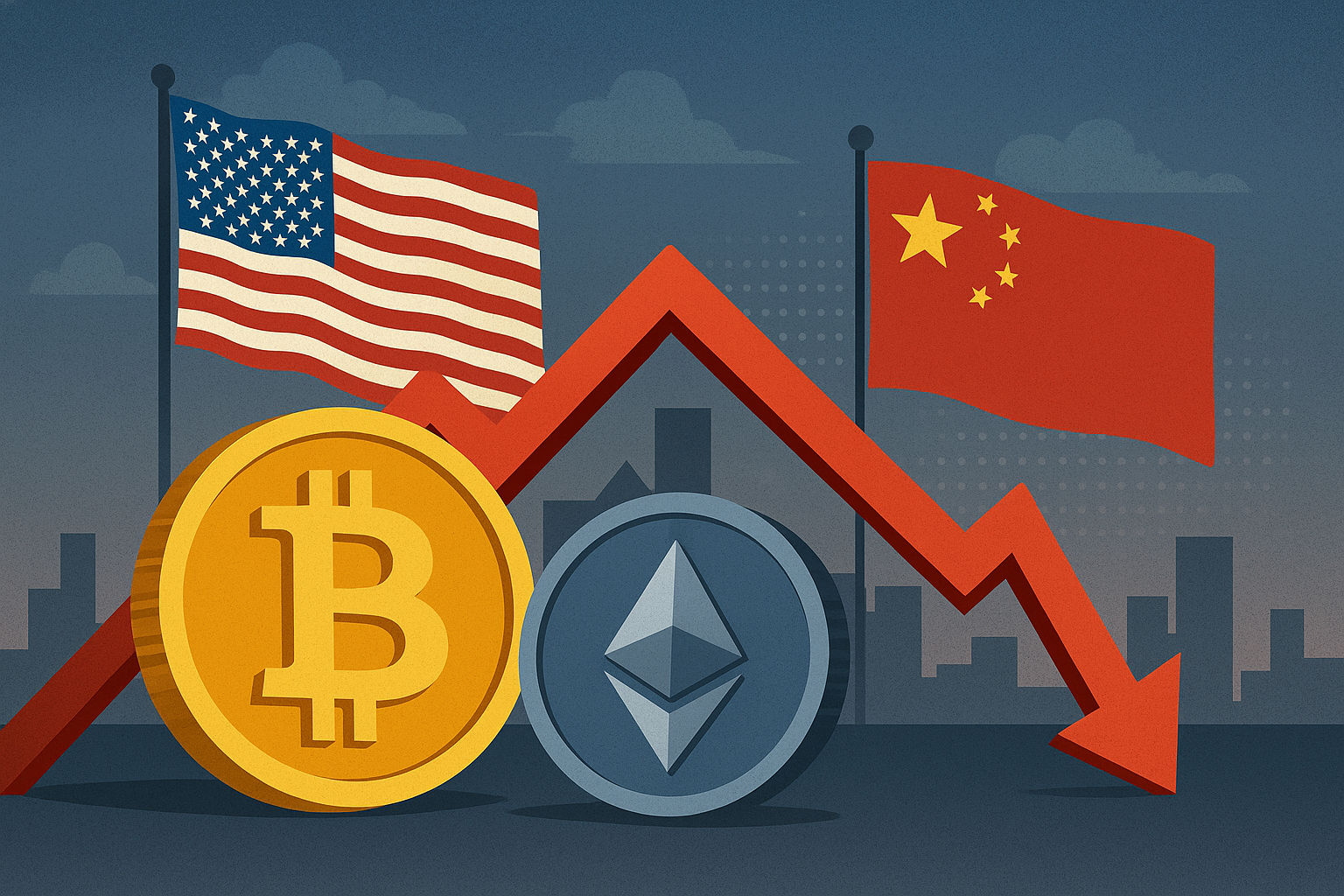When trade tensions flare, markets listen — and this week, so did crypto investors. Bitcoin and Ether slid between 2% and 4% on Tuesday, reversing recent gains as renewed tariff threats and port-fee escalations between the United States and China unsettled risk sentiment across global markets. The broader sell-off in digital assets, reported by Reuters, underscores how geopolitical uncertainty is increasingly shaping the trajectory of crypto valuations.
The Return of Macro Fear
The latest downturn came after U.S. officials imposed new tariffs on select Chinese imports and raised inspection fees at key ports — a move Beijing denounced as “economic coercion.” While traditional markets largely absorbed the shock, speculative assets like crypto faced immediate pressure.
Bitcoin briefly dipped below $61,000, while Ether fell under $2,300, mirroring declines in Asian equities and high-beta tech stocks. Altcoins — typically more volatile — suffered sharper losses, with analysts citing forced liquidations across leveraged futures markets.
“This looks like a textbook deleveraging event,” said a digital asset strategist at CoinShares. “When traders are running high leverage and volatility spikes, liquidations cascade quickly — especially in altcoin pairs.”
According to CoinGlass data, more than $500 million in leveraged positions were liquidated in 24 hours, one of the largest daily wipeouts since August.
Why This Matters for Investors
For investors, the episode serves as a reminder that crypto is now tightly coupled with global macro dynamics. As institutional adoption has deepened — through spot Bitcoin ETFs, futures markets, and crypto-linked equities — digital assets increasingly respond to geopolitical and monetary developments in the same way equities and commodities do.
The macro backdrop is complex. The Federal Reserve’s dovish tone earlier this week briefly buoyed crypto prices, but rising geopolitical friction has offset that optimism. Markets are now caught between hopes for a policy easing cycle and fears of worsening global trade fragmentation.
“Crypto trades as a high-beta risk proxy,” noted Bloomberg Intelligence analyst Jamie Coutts. “When liquidity expectations rise, Bitcoin benefits. But when macro risks flare — whether that’s trade, tariffs, or rates — capital flows reverse quickly.”
This dynamic has made crypto markets more globally integrated but also more fragile. Institutional inflows via ETFs and custodial platforms mean large redemptions can amplify moves in either direction.
The Structural Shift Underway
Beyond short-term volatility, this sell-off highlights a larger structural evolution in crypto markets. Unlike previous cycles driven mainly by retail speculation, today’s moves are influenced by institutional positioning, cross-asset hedging, and algorithmic trading tied to macro data.
Moreover, the increasing involvement of central banks and regulators adds a new layer of complexity. The U.S. Treasury and SEC have both signaled stricter oversight on digital asset custody and stablecoin transparency — developments that could dampen speculative activity but strengthen long-term legitimacy.
Meanwhile, China continues to clamp down on offshore crypto platforms while boosting its digital yuan ecosystem, framing crypto within a larger competition over monetary sovereignty. The tension between decentralization and state control will continue to define the global crypto narrative.
Future Trends to Watch
- Institutional Flows: Spot Bitcoin ETF volumes have moderated since summer highs, suggesting cautious sentiment. A rebound in inflows would be an early signal of renewed confidence.
- Macro Catalysts: Upcoming U.S. inflation data and Fed commentary could drive short-term direction. Rate-cut expectations may rekindle risk appetite.
- Geopolitical Developments: Further U.S.–China escalation — or any de-escalation — could swing crypto sentiment quickly.
- Regulatory Moves: Canada’s progressive crypto framework continues to attract listings and custodians. If the U.S. follows suit with clearer ETF and custody rules, institutional adoption could accelerate again.
Key Investment Insight
In this volatile macro environment, risk management is as important as conviction. Long-term investors may view dips in blue-chip tokens like Bitcoin and Ether as opportunities for gradual accumulation, especially if macro fundamentals improve in Q4.
However, traders should tighten stop-losses and limit leverage exposure, as short-term volatility could persist. Diversifying across correlated assets — such as crypto-related equities or blockchain infrastructure ETFs — may also help balance returns.
Crypto’s latest pullback is not an isolated event — it’s part of a broader pattern where digital assets increasingly mirror the global risk cycle. As geopolitical and monetary narratives collide, investors must stay nimble, disciplined, and informed.
For now, the message is clear: volatility isn’t vanishing — it’s evolving. Navigating it successfully will require not only belief in the long-term promise of blockchain, but also a sober appreciation of macro reality.
Stay ahead of market-moving developments with MoneyNews.Today, your trusted source for daily investor insights across crypto, AI, commodities, and global markets.





